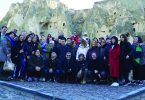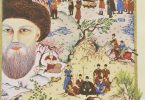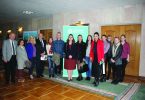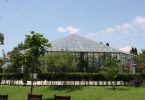A prominent figure in Turkish painting, Devrim Erbil attended Mimar Sinan Fine Arts University in 1955 as a student and retired in 2004 with “professor” title. He became the first Turkish artist to present the works he produced throughout half century to the taste of art-lovers in his exhibition titled “50 Years in the Academy” opened in Tophane-i Amire Culture and Arts Center. In his opinion, it is impossible to fit art on a single canvas. Therefore the artist does not only paint but also produces prints, marquetries, mosaics, ceramics, leaded glasses and carpet paintings. Known as the “Poet of Painting”, the artist first came in contact with art in his primary school years with writing poetry. Erbil acquainted with painting in his secondary school years says, “I will work as an artist until my last breath.”
■ What would you say if we asked you to explain your half a century of art life? We know you took interest in literature in your primary school years. How and when did you realize your interest in painting?
I am 79 years old and considering that, it would not suffice to go back to 50 years ago to comprehend how my art life began. I think the further we go back, the better. Of course I painted like every other child before primary school. Naturally it did not occur to me that painting is a special field in those years. Because there were no means for me to comprehend what painting or art were. I went to primary school in Balıkesir. Books intensified my interest towards literature. My sensitivity to art manifested itself in form of poetry. I started writing poems and short stories. I even entered an essay contest in primary school and achieved a place. I was painting at the same time however I was not aware that I was good at it. My secondary school teachers discovered my talent and I am a passionate art enthusiast since then. I ceaselessly paint and work on literature. Writing has always been a part of my life but poetry is a thing of those days.
■ What would you like to say about your years in academy and your dreams?
The name of Mimar Sinan Fine Arts University was Istanbul State Academy of Fine Arts back then. When I entered the Academy, my only dream was to work on what I loved, and that was painting. Even the concept of “State Artist” was not known in Turkey then. At the same time, selling paintings was out of question. I could not imagine having my works exhibited in museums in Turkey or abroad. In time many things have changed in Turkey and I reached a level I could not even dream of. When I entered the Academy, I faced some hardships as earning a living, and at the same time being a student and improving my career. I made sacrifices during that period. My late father would always tell me “Your body will complain about you in the afterlife.” I would wake up early in the morning and go to school. And then I would work until midnight. I worked at fairs, and as a railway man. I also had assignments and would work to complete those. I could return to dormitory at 3 in the morning. In short, I spent my life working.
■ What has Devrim Erbil achieved throughout his art life?
I tell myself “Once I achieve this goal, I will lead a quiet life.” Then I find myself burdened with another responsibility. I thought I would feel more relaxed upon retirement, now I see I am busier than ever. I teach at several universities; organize exhibitions both home and abroad; I give conferences. I worked as the Director of Istanbul Art and Sculpture Museum for some time. I published art magazines throughout my Academy years and I was always in charge of cultural events called “Art Festival”. Thank God I had enough energy. I will work as an artist until my last breath. I have an exhibition here, and I might have another exhibition somewhere else. I would like to carry out projects for cities as well. In this context, I have suggestions regarding Gaziantep and I will share with the respective mayor. I also have projects for children and Devrim Erbil Modern Arts Museum located in Balıkesir. The museum in Balıkesir features around 200 works; not only my works but works by my friends as esewell as paintings donated by numerous known artists. I also set up a foundation. This was my biggest dream. I am the artist who has opened the highest number of exhibitions in Turkey. I have confidence abroad as well, each year I have three to five exhibitions in various countries. I have exhibitions all around the world. I particularly attach importance to opening exhibitions abroad for being acknowledged and for promotion. I explain Turkish art in the countries I visit. Sometimes I get a full page coverage in foreign press. This makes me happy both as an artist and a person serving Turkish culture. Art can never fit in a single canvas. Some might be contented with it but I desire art to become popular.
■ Have you had style changes from the time you began your art life to this day?
There is a common denominator in my paintings with regard to style but of course they have differences in themselves.The work I produced when I was studying cannot be at the same level with my last painting. Because both the artist and the time change. New elements enter art with each new period. There is such a thing in art: Being loyal to one’s own essence. This is what I do, this is me respecting my essence. If someone looks at a painting from a distance and says “It is a Devrim Erbil painting,” that’s it.
■ How did Bedri Rahmi school influence your art? You say “I cannot turn down the exhibition proposals from Anatolia.” “I collect my art from Anatolia.” Could you address the place of Anatolia in your art life?
One is naturally influenced by the cultural structure and values of these lands. It is impossible to live here and not be inspired by Anatolia. However as an artist, Bedri Rahmi played a major role in Anatolia inspiring me by choice. Even our professors imposed Western culture upon us throughout art education, Bedri Rahmi led us to observe Anatolia and other cultures. Bedri Rahmi both taught us to learn about and adore Anatolia and focus on carpet art. We took it a step further and produced art setting off from cultural values of Anatolia. We accepted the sum of Anatolian values and values of other cultures as our own and focused on those as their inheritors.
■ In parallel with this, can we say that you are focused on carpet paintings?
I attach importance to carpet paintings. Because carpeting is a technique Turks presented to humanity; it is a part of Anatolian culture. If Western artists employ various techniques and make carpet paintings, why can’t we? I have a carpet workshop in Balıkesir. In addition I have a project that will feature 25 silk carpets. Each corner of Anatolia where carpet is made, is the center of carpet-making. Uşak is one of these. My ather’s family is from Uşak. Im suggested Uşak Municipality to open a carpet-rug painting museum titled “From Tradition to Modern”. The idea found support and now my works are featured there as well. Art of carpet-making should be revived. I plan to organize major exhibitions and tour all over the world. I believe that these are as interesting as my paintings.
■ The color blue, Istanbul and birds have an important place in your works. What are the significance of these concepts for you?
Color blue with psychological effects is identified with Istanbul for once. Blue Mosque is located in Istanbul. Besides its sky is blue, tiles are blue… Particularly turquoise blue suits Istanbul well. Turquoise is a green blue. I add a bit of ultramel to it and that color is called “Devrim Erbil blue”. It is impossible to ollive in Istanbul and not paint it. Birds are the rhythm of life. Their flutters create arhythm; and that demonstrates the flow of life. It is in the rhythm of life. Life as a whole is the rhythm of flutters; what these bring along is sound, music.
■ Can you share the secrets to your success to set an example to young artists? What are your suggestions for young artists?
It is important to use the opportunities and pay efforts to get somewhere. I set an example: what can the child of an ordinary civil servant achieve if he loves art? I worked while I was studying in the academy. Then I worked as a teacher, artist, museologist and at the same time carried out cultural activities, I managed to overcome all and I am here now. Besides I feel lucky to be an Academy graduate and am thankful for my professors. It sounds ordinary but success is based on work. You must madly, passionately devote yourself to your work consuming yourself. I tell my students “Art is not an ungrateful lover. Give yourself to it, your sleep, your holidays, your good memories. And it will provide you with what you want.”
■ We know you have a project for Bodrum which you wish to transform into a city of art. Why Bodrum?
Bodrum is a global brand. Besides it is an extraordinary city with its weather and nature where artists can produce. The city’s population reach to 1,5-2 million in summer; the winter population is around 140 thousand and there are serious investments. These investments and organization should reach larger masses. In this context, we have a museum project for Bodrum. This museum project to be located in Ortakent Bodrum means a lot to me. This was not originally my idea, but an idea of Bodrum Mayor Mehmet Kocadon and businessman Yüksel Çağlar. They are important figures in forming Bodrum’s identity and determining its destiny. This dynamism that brought me to Bodrum, will also accelerate the efforts to make it an art city. I am utterly glad to be a part of these efforts. I really wish to open a modern museum carrying my name in my place and exhibit exclusive paintings there.
SOME MUSEUMS FEATURING WORKS BY DEVRİM ERBİL:
Istanbul Modern Art Museum, Anadolu
University Museum (Eskişehir), Trakya
University Museum (Edirne), Ben and
Abby Grey Foundation (Minnesota, USA),
Museum of Contemporary Art (Skopje),
Banja Luka Umneticka Galeriya (Bosnia-
Herzegovina), Alexandria Museum of Fine
Arts (Egypt), Museum of Contemporary
Arts (Bucharest), National Museum
of History (Taiwan), Palacio National
de Ajuda (Lisboa), Georgian National
Museum (Tbilisi), Tirana National
Museum (Tirana).









Leave a Comment